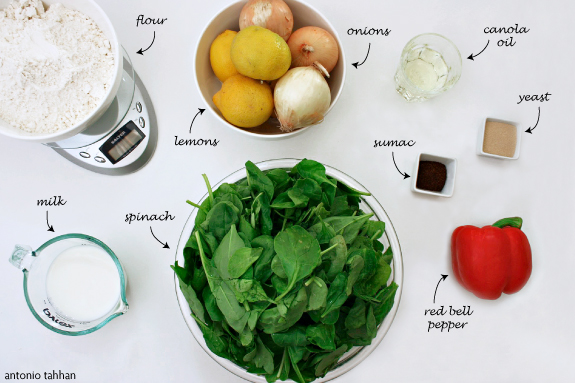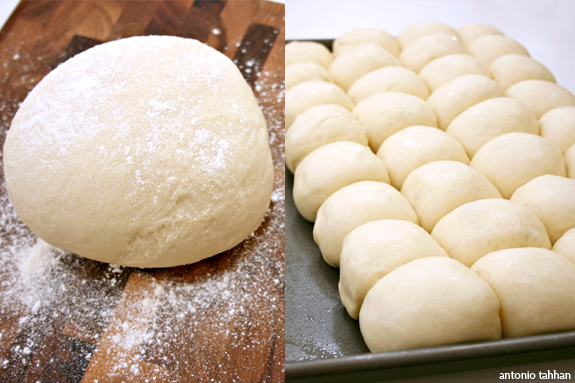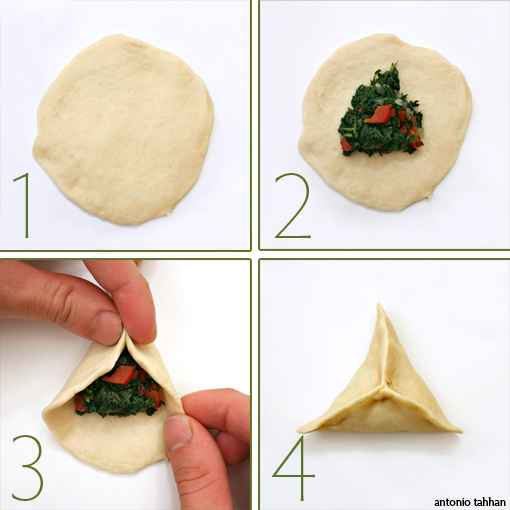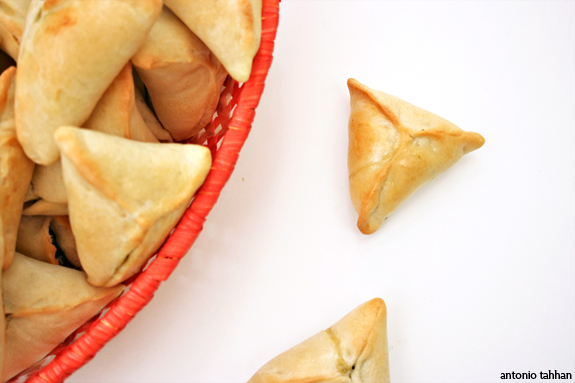If I had to pick one dish to become a vegetarian for, it would be fatayer (فطاير).
It’s a strong statement, and I’m not sure whether I would actually do it, but hypothetically, if I had to choose one dish to give up meat for, this would be the one. That’s all I’m saying.
My sito is an expert at making these, and I’m not just saying that because she’s my grandmother. She’s good — not only at making these pies, but at everything she cooks, really. There’s a saying in Arabic, يسلم يدك (yeslamou eedaik), that is used to thank a cook for preparing a delicious meal — it literally translates to, bless your hands. My grandmother’s hands have been blessed plenty of times. The truth is, she’s happiest when she’s cooking, and it shows in the food she prepares. It runs in her veins, and even mine, she tells me.
Fatayer is a simple dish, in theory: just dough and filling. The dough can be made with either milk or water. My grandmother tells me she makes hers with water, but that she’ll sometimes use milk (or powdered milk), depending on what she has on hand. Somehow she manages to make both versions taste equally amazing. I am convinced her hands are blessed! Luckily, we live in the age of twitter and blogs and facebook, so I knew this would be a perfect question to ask tweet Anissa Helou. Chef Helou is a Mediterranean food scholar and instructor based in London, who also keeps a Mediterranean food blog. To her knowledge some cooks use milk in Syria, but no one does in Lebanon. My grandmother is Syrian, so this made sense to me.

I have a feeling there will be some tension around the red bell pepper. While the red bell pepper is not traditional, I don’t think, it works on many levels – photogenically and culinarily. The specs of red in the filling add contrast to the shades of dark green spinach, while adding a subtle sweet undertone to the dish. It works. Try it, at least once, and let me know.

The filling starts with freshly chopped spinach. I used baby spinach, but that wilts down to almost nothing. In the end, any spinach will work. After you roughly chop the leaves, add salt to release the water from the spinach and let sit for 5-10 minutes, while you prepare the dough.


If you’re using dry, active yeast, you don’t necessarily need to make it bloom. I do this as a check to make sure that my yeast is alive and well. Simply add the yeast to warm water with a bit of sugar or honey, cover and let sit for 10-15 minutes. If it gets bubbly and foamy, it’s alive, if not, you just saved yourself a lot of frustration (and cussing).

The smaller you make the dough, the prettier the fatayer will be, but the more patience you’ll need. In the Middle East, these involved dishes are almost never prepared alone. The women of the family usually gather to help the host and also take that time to catch up with each other and talk about stuff I wasn’t allowed to listen to as a child.

Just imagine how much quicker this would be if you had four or five pairs of hands helping you.

Once they’re all formed, make sure the seams are well-sealed before they go into the oven. I like to brush the surface of mine with a little milk, or a light egg wash, just to give the crust a nice sheen after they come out of the oven.


These pies are surprisingly better the next day, at least in my opinion. You can heat them up for 7-10 seconds in the microwave, or eat them at room temperature, which is what I will usually do.
Spinach Fatayer
yields approx 32
Components
Dough:- 425 g. flour (approx 3 cups)
- 3/4 cup milk*, warm
- 1/2 tsp sugar or honey
- 1 tsp dry active yeast
- 1/4 cup canola or olive oil
Filling:
- 500g spinach, roughly chopped
- 1 medium onion, grated
- 1 red pepper, finely diced
- juice of 2-3 lemons, to taste
- 2 Tbsp olive oil
- 2 Tbsp sumac
- salt and black pepper, to taste
Putting them all together
Dough- Bloom the yeast to make sure it is alive. Add the yeast to the warm milk with the half teaspoon of sugar or honey. Cover and set aside for 5-10 minutes.
- Prepare the dough by mixing the oil with the flour and slowly mix in the yeast-milk mixture. Add salt to taste and knead for 10-15 minutes or until the dough is soft and elastic.
- Divide the dough into individual balls (golf ball size) and cover with a damp towel while you prepare the filling.
Filling
- In a large bowl, mix roughly chopped spinach with salt until well combined and set aside for five minutes until the salt starts draw out the water from the spinach.
- Grate onion and squeeze as much water from it as possible. Alternatively, you can pulse the onion in a food processor to minimize crying. Combine with diced pepper and set aside.
- Squeeze out as much water from the spinach as you can.
- In a large bowl, combine all the filling ingredients together.
Assembly/Baking
- Begin forming the fatayer by flattening out each piece of dough. It helps to do this on a lightly oiled plate. If the dough begins to contract too much, that means it is not well rested yet.
- Add a spoonful of the spinach mixture to the center of the disc while making sure to keep the sides clear of oil or filling. This will help create a better seal later.
- Crimp the dough into a triangular shape and set on a parchment lined baking sheet.
- Brush with milk or a light egg wash (optional) and bake in a 450 degree F oven for 15-20 minutes, or until golden brown.
- Serve at room temperature.

Ohh, definitely going to make this, looks very yummy! But…where can I get sumac?
oh, ps – I have a giant, flourishing Basil plant now 🙂
Bless grandma’s hands from me too!
These look absolutely perfect and delicious!YUM!
What I love the most about many foods of different cultures is the togetherness aspect in the preparation.
This sounds delicious, and looks equally as good! Even if the red bell pepper isn’t traditional, it puts your own spin on it and it does make a difference it the appearance. While I feel it’s good to respect traditions, there’s nothing wrong with adding a new twist.
I love this recipe, and i’ll do it for sure.
Thank you for sharing.
Regards from Portugal
Moira
Beautiful Antonio! I love the addition of bell peppers! Bless your grandmother’s hands (And yours too!).
As usual, Tony, you rock. Great post.
OMG Tony,I do so agree..Fatayer is an absolute delicacy!My favorite though is with fresh Zaatar leaves which is a bit complicated if you dont live in the region..but sooo special! Could u believe I was crazy enough to sneak a wild zaatar plant into my suitcase when I was living in Paris..and successfully grew it(together with a wild Miramiya-Sage)on my Parisian studio windowsil,just so I can enjoy its fresh leaves daily?!Magnuna,no?:)
Thanx once again for bringing us one of the beautiful recipes of the Middle East,and definitely bless your grandma`s hands as they have obviously blessed your own..! Mia
These look delicious and do sound like they are worth every step!
Love that saying about hands being blessed…truly!
Bless you hands indeed! I need to go get sumac, have been wanting for a long time to refill my stock. This is so beautiful & almost looks like a “Samosa”. wonderful flavors inside.
Thank you for the wonderful comments!
Raquel – you could buy sumac online these days, on amazon even. In NoVA there’s also a huge Middle Eastern community so you could buy sumac at any of the Mediterranean shops in that area. I bought some a couple months ago at the Mediterranean Bakery in Alexandria. Congrats on your basil – are you going to turn it into pesto before winter starts?
Mia – I have not had fatayer with fresh za’atar leaves – that sounds awesome though. hehe, ante mish magnuna, ante very cool 😀 I hope to make it out to the Middle East this year for a cousin’s wedding and will be on the look out for fresh za’atar. shukran!!
Joey – thank you! I always thought that was a neat saying – I’m glad you liked it. الله يسلمك (Allah yasalmek)! That is the response to “bless your hands” – it translates to “God bless you”
Those are so delicious. Love your pictures.
Hi Tony. I just found your blog and I am so impressed. I love Middle Eastern food because I grew up in Metro Detroit. I’ve seen these Fatayer in the Lebanese bakeries in Dearborn. There is some seriously great food there and on your blog.
These are absolutely delicious!
تسلم إيدك
marhaba tony
hmmmm so delicious, beleive me: am moroccan but I love syrian food especially your fatayers
thankss for the recipe but i can’t find sumak in morocco, we don’t use it in our cuisine
your dough looks delcious you’re a good cooker so tselem diyatek and diyat sito
Touria
Hi Tony
great post as always.
For spinach fatayer I use pomegranate seeds both for taste and some colour. It works very well.
Wonderful post. These are a favorite of mine. Thank you so much for the detailed instructions. I’m going to book mark this and try them myself.
Fabulous post! I love fatayers too!
Man, the photos are incredibly yummy!
That’s saying something … when a dish could possibly turn you into a vegetarian! I have one or two like those in my mind too. These are adorable, and the flavors must really pack a punch.
That just looks amazing … your site looks amazing!
I shall try and see if my hands have been blessed!
How very lovely!! And there is similar saying in Turkish 🙂
OH. I love these. I mean, I haven’t made them yet, but I can tell I love them already. Can you make them with cheese?
I first came across your blog when you posted about gnocchi and hadn’t come back till I saw this post. There was a local shop here called Droubi’s (a middle eastern shop) where I would by these spinach fatayer but it closed down and I’ve been wanting to have them ever since. I made them two nights ago and they were a hit with my family! Thank you for the great recipe, I will be blogging about it on my site soon. And will be visiting your blog more often. 🙂
Hi,
I have just discovered your amazing site !
Your photos are really great !
As a Syrian, i’m very happy to find so well explained recipes, thank you !
Hi Tony,
Here in Greece we have a similar wish which is ‘γεια στα χέρια σου’ and means health to your hands. These look great my grandmother was an excellent cook as well. I always remember the smells of cooking coming from her kitchen as I was entering her house.
Great recipe, I made fatayer last year from wild spinach which I bought at the shuk, the second time I forgot the soumak and it wasn’t as good…
forgot to add, the Israeli-Arabs make it with milk, at least the ones that run the el-babour restaurant
shou hal aklat el taybe ya abou el ton yeslamou 2idek 😀
bas bdna ndou2on 😛
I love this saying and this post. Gorgeous pictures.
Just wondering, can this be made with meat filling? I’ve been dying to learn how to make meat pies! I delicate buttery dough and meaty filling! Thank you.
MsHymanRoth: These can definitely be made with meat fillings. In fact, some of the most popular fillings in Syria are meat, cheese, za’atar (زعتر), red peper paste, and the spinach ones I blogged about. I will try to post a recipe for the meat variation soon. Thanks for your comment!
Your the best !!!
Love your blog….
Thanks….
Best
Barbara
Marhaba Toni,
Shokran ya basah, mallem shater wallah!Yummy,
I used to do fatayer, but now I am going to use your method and use the red bell pepper.
I have 2 questions:
1. How much salt you are adding to the spinach?
2. Do you wash the spinach off the salt after 10 minutes?
sorry i don’t speak english very well your blog is formidable mais dommage il n’y a pas de traduction en français .Est ce que vous pensez faire un jour cette traduction et des abonnements.Merci.
I understand your love for Fatayer, I lived in UAE for 30 yrs and always loved them but never attempted to cook them my self ( may be because there was a bakery in the building that I lived in) I now live in US and have made them at home so many times but now my sister in law wants them for her birthday next week for 75 people and I have searched so many sites yours is the only one that gave me an accurate measurement as to how many I can get. God bless your hands!
Just landed on your blog, I was happy to see many Lebanese recipes! I love fatayer but yours looks absolutely gorgeous and delicious!
Wow. You don’t roll your dough out and then cut it with a round cutter. Brilliant!!! I seriously can’t wait to try this method. Both of my in laws were from Syria. I’m constantly trying to improve my Lebanese/Syrian cooking.
I visited Syrian once and had some amazing food there. One of my favorites was some pastries my sister in law purchased. Don’t know what they were called but we some small turnovery type pastries filled with different meats, cheeses and spinach. They a were to dye for and I have been searching for a receipe. Do you know what I am referring to and do you have a receipe?
@Jacki–Thanks for the comment! I wonder if you’re referring to sambousek. If you do a google search on sambousek, does that look similar to what you had? If not, it might have been fatayer (the recipe on this post), but with different fillings like meat or cheese. I’ll also ask my grandmother to see what other meat/spinach/cheese filled pastries are found in Syria. Do you remember what city in Syria you had them in? Cheers!
Thank you so much, yes that does look like them. I can’t wait to try this. I was visiting Damacus when I enjoyed these pastries. Was a great time.
Thanks for your response. My former mother-in-law came from bedouin decent and she was an amazing cook. Never had a receipe or would write one down, but she and all her daughters could cook. There were several meals I will never forget and of course couldn’t write them down. She made a red rice and lamb stew so to speak, where she boiled the lamb and added tomatoes or sauce to the rice and cooked them all together with cardamom seeds, I think. My daughter also remembers a dish that she cooked with meat and boiled eggs, a sort of casserole. Do you know of any of these dishes or a cookbook of authentic middle eastern food?
many levantine cooks add peeled,seeded and diced tomatoes rather than a bell pepper for color.contrast.taste
thanks a lot for this recipe.but i am asking can i fry them and alo can i use meat instead of spinach.
Hi Khadija! I’ve heard of people frying the fatayer and using meat in the filling. Usually when people use meat in the filling, they will add pine nuts, too. I hope this helps.
hey tony,
i actually tried the recipe for the dough. just wondering if u missed out 1 cup while typing the amount for the milk. 3/4 cup of milk/water was too little for 3 cups of flour so i just added more.
i had curried potatoes with some chicken for the filling, like that in fried curry puffs in Singapore and Malaysia cos i wanted a healthier baked version. it became a ‘reduced-sodium’ version cos i forgot the salt for the dough…bummer. i’ll probably attempt the recipe again, this time with the spinach.
🙂
Hi Jieyu! Thanks for the comment. The curried potatoes with chicken sounds yummy; almost like a samosa? I remember using 3/4 cup of milk for this recipe, but one thing that comes to mind is the difference in flours — some flours absorb more liquid than others. If the dough was still dry with the recommended amounts of oil and milk/water, you did the right thing to add a bit more liquid. My only suggestion would be to knead the dough for a few minutes before adding extra liquid. This is because it takes a little time for the flour to absorb all the liquid. I hope this helps! Enjoy the spinach variation 🙂
I have made these twice now; once with milk and once with water. They are both equally good. I found the water recipe to be a little more moist. Either way, the dough is so lovely to work with.
I have to say, though, the red pepper is a genius addition and I am not sure that I could go back to eating another fatayer bi spanigh without it. I’m officially a convert.
Salim dayatuk et Merci, Tantoun!
Hi Tony I just found your blog, it is great! I love this recipe and I can not wait to try it out? But can you specify which flour to use, self raising or plain flour